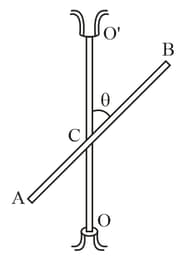HARD
JEE Main
IMPORTANT
Earn 100
The midpoint of a thin uniform rod , of mass and length , is rigidly fixed to a rotation axle , as shown in the figure. The rod is set into rotation with a constant angular velocity . Find the resultant moment of the centrifugal forces of inertia, relative to the point , in the reference frame fixed to the axle and to the rod.



Important Questions on PHYSICAL FUNDAMENTALS OF MECHANICS
HARD
JEE Main
IMPORTANT
A conical pendulum, a thin uniform rod of length and mass , rotates uniformly about a vertical axis, with angular velocity ( the upper end of the rod is hinged. Find the angle between the rod and the vertical.
HARD
JEE Main
IMPORTANT
A uniform cube, with edge , rests on a horizontal plane, whose friction coefficient equals . The cube is set in motion with an initial velocity, travels some distance over the plane and comes to a stand-still. Explain the disappearance of the angular momentum of the cube, relative to the axis lying in the plane, at right angles to the cube's motion direction. Find the distance between the resultants of gravitational forces and the reaction forces exerted by the supporting plane.
HARD
JEE Main
IMPORTANT
A smooth uniform rod , of mass and length , rotates freely with an angular velocity , in a horizontal plane, about a stationary vertical axis passing through its end . A small sleeve of mass starts sliding along the rod from the point . Find the velocity of the sleeve, relative to the rod, at the moment it reaches its other end .
HARD
JEE Main
IMPORTANT
A uniform rod of mass and length , rests on a smooth horizontal surface. One of the ends of the rod is struck with an impulse , in the horizontal direction, perpendicular to the rod. As a result, the rod obtains the momentum . Find the force that one half of the rod will apply on the other, in the process of motion.
HARD
JEE Main
IMPORTANT
A thin uniform square plate, with side and mass , can rotate freely about a stationary vertical axis, coinciding with one of its sides. A small ball of mass , flying with velocity , at right angles to the plate, strikes elastically at the centre of it. Find:
the velocity of the ball after the impact;
the horizontal component of the resultant force, which the axis will exert on the plate after the impact.
HARD
JEE Main
IMPORTANT
A vertically oriented uniform rod, of mass and length , can rotate about its upper end. A horizontally flying bullet, of mass , strikes the lower end of the rod and gets stuck on it; as a result, the rod swings through an angle . Assuming that find
the velocity of the flying bullet
the momentum increment in the system "bullet-rod" during the impact; what causes the change of that momentum
at what distance , from the upper end of the rod, the bullet must strike, for the momentum of the system "bullet-rod" to remain constant during the impact.
HARD
JEE Main
IMPORTANT
A horizontally oriented uniform disc, of mass and radius , rotates freely about a stationary vertical axis, passing through its centre. The disc has a radial guide, along which can slide, without friction, a small body of mass . A light thread, running down through the hollow axle of the disc, is tied to the body. Initially, the body was located at the edge of the disc and the whole system was rotated with an angular velocity . Then, by means of a force applied to the lower end of the thread, the body was slowly pulled to the rotation axis. Find:
the angular velocity of the system in its final state;
the work performed by the force .
HARD
JEE Main
IMPORTANT
A man of mass stands on the edge of a horizontal uniform disc of mass and radius , which is capable of rotating freely about a stationary vertical axis passing through its centre. At a certain moment, the man starts moving along the edge of the disc; he shifts over an angle , relative to the disc, and then stops. In the process of motion, the velocity of the man varies with time as . Assuming the dimensions of the man to be negligible, find:
the angle through which the disc had turned by the moment the man stopped;
the force moment (relative to the rotation axis) which the man applied on the disc, in the process of motion.
